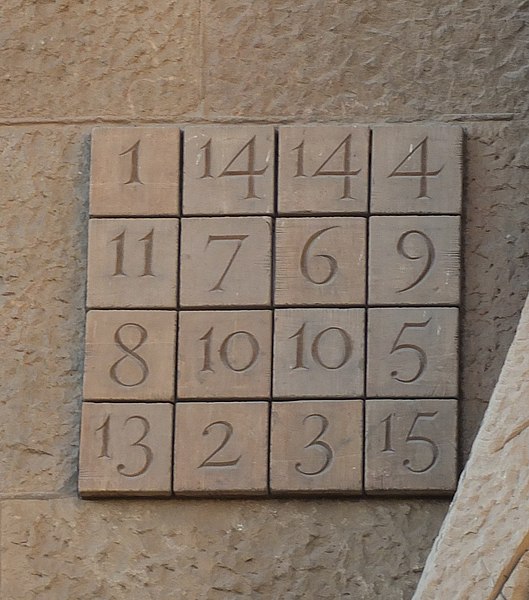 Maths, Physics & Chemistry
Maths, Physics & Chemistry
Magic Squares: A children’s puzzle meets quantum physics
A magic square is a grid of numbers where every column and row sum up to the same number. We explain the “quantum jump” for magic squares, generalizing them to the mathematical framework of quantum physics to interpret quantum measurement. We investigate the properties of these newly established quantum magic squares and find that the quantum world is even more magic than we thought before!

Magic squares have fascinated people for centuries. A magic square is a grid of numbers such that every column and row sum up to the same number, called the “magic constant”. For example, a magic square can be seen on the façade of the Sagrada Família church in Barcelona, where every row and column sums to 33. It is generally not obvious how to place numbers so that they form a magic square. For example, a sudoku puzzle is a very special type of magic square where every row and column sums to 1+2+ … +9. Magic squares are not only puzzles, but can have actual real-world applications: for example, web search engines like Google use them to determine the significance of a web page for their search results.
When we divide every entry of a magic square by the magic constant, we obtain a grid of positive (or zero) numbers where each row and column sum up to 1. These will be —for the rest of the article— our magic squares. For example, we obtain such a magic square by dividing every number in the Sagrada Família’s square by 33.
Let’s look at some extreme examples of magic squares. Consider a grid of any size, and place a 1 on the diagonal from the upper left to the lower right corner, and 0s everywhere else. Then the sums of the rows and columns are all 1, so it is a magic square! That was easy. What if we swap columns (or rows) of this grid? — for example, we can swap column 1 and 2. There will still be a 1 in every row and column, and 0 elsewhere (the 1’s will just be displaced from the diagonal). So this is also a magic square! All these types of magic squares are called “permutation matrices”.
A famous result shows that all magic squares can be obtained by “averaging” over permutation matrices. For example one can choose two permutation matrices and form a new grid by putting the mean value of the entries of the initial two. More generally, one can take a “weighted” average, where different permutation matrices are given higher “weight” (or importance) and thus different matrices contribute differently. To put it another way, if we think of permutation matrices as points in space, then the average is somewhere in the middle between these points, where it is closer to points with higher weight and further away from points with lower weight.
Now, numbers between 0 and 1 can be interpreted as probabilities. Famously, in quantum physics, we cannot predict the outcome of a measurement with certainty, but we can give the probability for it to occur. Each measurement outcome is described by a grid of numbers called a “positive semidefinite matrix”. A “quantum magic square” is a grid containing a positive semidefinite matrix in each row and each column. This is a grid in which each entry is itself again a grid, maybe even of a very large size! Now each row and column of a quantum magic square can be interpreted as (the mathematical description of) a measurement and each individual entry describes the outcomes of the two measurements associated with the row and the column.
In our paper we ask whether these complex quantum magic squares can also be characterized in terms of some easy ones. In particular, the easy ones are “quantum permutation matrices”, which are quantum magic squares where every little matrix (each grid entry) is equal to the product with itself — since this is what happens for permutation matrices which only contain 0 and 1s, the only numbers that square to themselves. We thus want to know whether quantum magic squares are averages of quantum permutation matrices. Our main result reveals that this idea fails! In fact, it fails to be true even in the simplest nontrivial case. This tells us that quantum magic squares contain even more magic than classical ones. This result underscores that the quantum world is much richer and more fascinating (and thus more “magic”) than the classical world.
Original Article:
De las Cuevas, G., Drescher, T. & Netzer, T. Quantum magic squares: Dilations and their limitations. Journal of Mathematical Physics 61, 111704 (2020).Next read: A tool for precisely modelling real-world quantum devices by Moritz Cygorek , Erik Manuel Gauger
Edited by:
Aleksa Djorovic , Senior Scientific Editor
We thought you might like
Silencing a quantum drum
Feb 27, 2019 in Maths, Physics & Chemistry | 4 min read by David Mason , Massimiliano Rossi , Albert SchliesserMore from Maths, Physics & Chemistry
Testing gravity through the distortion of time
Sep 20, 2024 in Maths, Physics & Chemistry | 3 min read by Sveva CastelloStacking molecular chips in multiple dimensions
Aug 30, 2024 in Maths, Physics & Chemistry | 3 min read by Lucía Gallego , Romain Jamagne , Michel RickhausReversible Anticoagulants: Inspired by Nature, Designed for Safety
Jun 12, 2024 in Maths, Physics & Chemistry | 4 min read by Millicent Dockerill , Nicolas WinssingerDistance-preserving moves always keep a point fixed
May 18, 2024 in Maths, Physics & Chemistry | 4 min read by Shaula FiorelliA resonance triggers chemical reactions between the coldest molecules
Apr 5, 2024 in Maths, Physics & Chemistry | 3 min read by Juliana Park , Wonyl ChoiEditor's picks
Trending now
Popular topics


